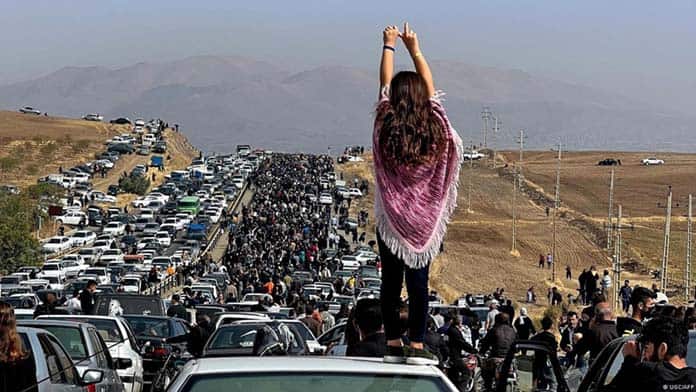Protest and rebellion have swept Iran for almost two months since the murder of 22-year-old Mahsa Amini by the regime’s notorious morality police, after her arrest for wearing her headscarf improperly.
The protests have rapidly became an open challenge to the authoritarian regime, calling directly for its overthrow.
As well as the leading slogan of “woman, life, freedom”, popular chants raised during protests include “death to the dictator” and “neither shah, nor mullahs, I support the people”. In early November University students in Tabriz chanted “with or without the hijab we’re heading for revolution”.
The 40th day since Mahsa Amini’s death saw one of the biggest days of protest so far. In her home region of Kurdistan thousands defied state repression to march to the cemetery in Saqqez where she is buried. Security forces reportedly tried to shut off access to the cemetery but were unable to stop the tide of mourners.
Protests were reported across at least 45 cities. In Tehran there were protests in dozens of neighbourhoods. Videos posted on social media show many crowds in the streets in many cities and Tehran’s bazaars shut down with protesters chanting “death to Khamenei”, the country’s Supreme Leader.
Footage appears to show protesters in the city of Tabriz using Molotov cocktails in response to police gunfire and hurling objects onto security forces from the roof of a building in Tehran’s Sepahsalar Street shopping area.
University campuses have become a centre of the movement. In early November students in Tehran and other cities staged strikes despite the intensifying crackdown.
Videos posted on social media show students gathered in courtyards, corridors and roads on campuses chanting anti-regime slogans and holding signs demanding the release of imprisoned classmates.
At Sharif University in Tehran students broke sexist rules that prevent men and women eating together in the canteen.
Schools have also been a hotbed of rebellion with dozens of school children among those killed and injured by regime security forces.
Workers’ strikes
Despite the heroism of the movement the regime remains powerful and has shown little sign of making concessions. Instead, it has intensified repression with hundreds being killed and up to 14,000 arrested.
Deepening the movement to involve widespread workers’ action is essential if it is to withstand the repression and topple the government. During Iran’s 1979 revolution, it was the power of oil workers’ strikes to halt production that finished off the Shah’s regime. Workers took control of the factories and took a leading role in the revolution.
In late October school teachers in the Kurdish province went on strike for two days against the government crackdown on protests.
Sections of oil workers in the south of Iran also launched strikes against the government in October. And there have been reports of strikes by tanker drivers, steel workers and tyre makers.
But workers’ actions have so far been only on a limited scale, with protests overwhelmingly taking place in the streets and universities.
Amid high unemployment and extraordinary inflation, the protests are a lightning rod for wider discontent. Since Iran’s government began a process of “opening up” to the market in the 1990s the country has seen price controls and subsidies abolished and waves of privatisation. The gap between rich and poor has grown.
According to the BBC the cost of goods and services has increased by 1135 per cent over the past decade. In just one month this year, food prices jumped 26 per cent. Inflation is projected to reach 47 per cent by March.
Against this dire economic backdrop, the Iranian government is terrified of the working class being drawn behind the protests. According to Foreign Policy magazine, in October management at Haft Tappeh Sugarcane, a large state-owned firm, were urged to “do anything to prevent workers’ protests.”
One day before a planned protest, management suddenly agreed to pay out months of delayed wages. More recently, the Persian Gulf Mining and Metal Industries Special Economic Zone called on major employers in Hormozgan province to pay wage arrears “in order to prevent workplace grievances that might become a reason for participating in protests.”
After strikes broke out in the petrochemical sector the Haft Tappeh Sugar Cane Company Workers’ Union issued a statement in solidarity with the protests, a section of it reads:
“Girls of the sun and of the revolution;
“On the day of victory, the whole world will take off their hats in front of you—you gave everyone a lesson in standing up and resisting.
“Long live the union and class solidarity of the workers for liberation!
“Towards a nationwide strike in the services and production sectors!”
This is the kind of action necessary to bring down the regime.
By Adam Adelpour






